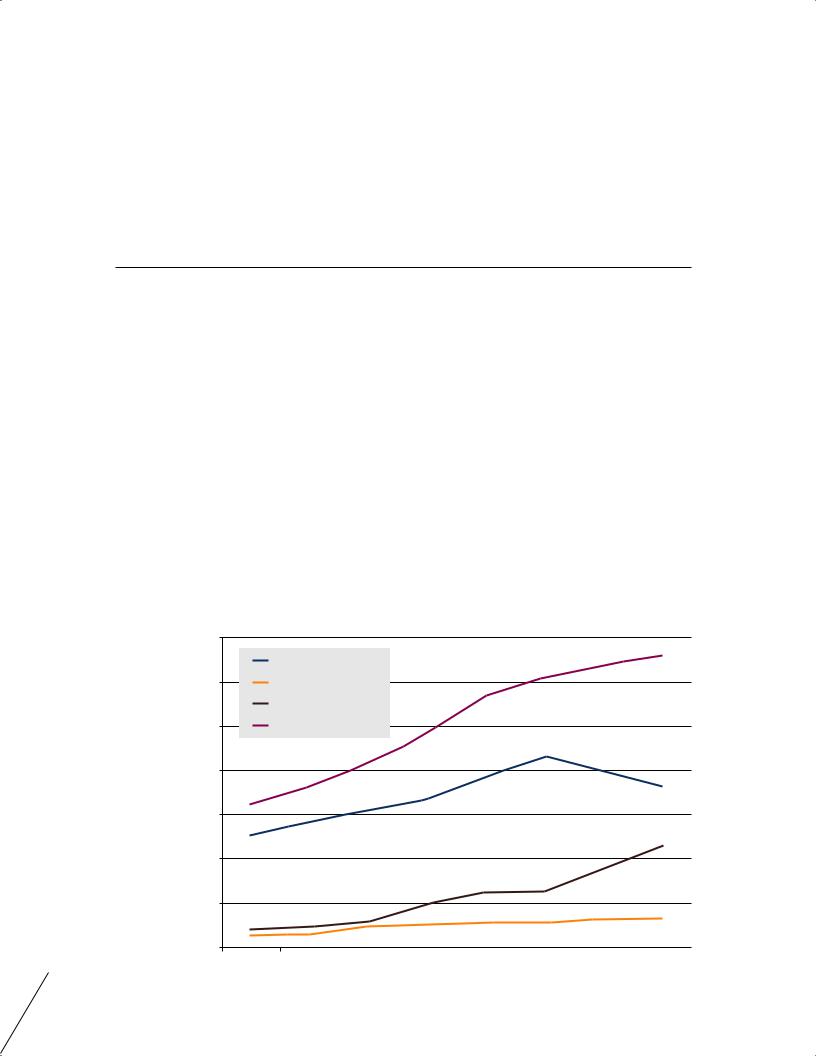
MIT-Skoltech entrepreneurial ecosystems report 2014 _1
.pdf
overseas, a high proportion still spend two to five years outside the country “travelling, taking bar jobs and seeing the world”. Interviewees described how these individuals “come back [to New Zealand] broke, in their late 20s and often with family responsibilities”. Although these “returning Kiwis… are more
mature, more experienced and more desirable employees after their overseas experience”, many interviewees observed that they often faced an increased pressure to “settle down and get a reliable job that puts food on the table” rather than “doing crazy things like starting companies”.
•Lack of motivation to innovate: Some interviewees spoke about the “comfortable life” enjoyed by professionals in New Zealand, leading to “lower aspirations to innovate and take risks”. As one observed,
“in New Zealand, once people have their three Bs, their boat, their batch and their BMW, it is hard to motivate them to take a risk”. Others also spoke about the difficulty of encouraging ambitions for international growth amongst small, established business where “for many people, success is having ten employees and taking home a small profit”.
•Quality and balance of startup teams: As a result of the immaturity of the entrepreneurial ecosystem in Auckland, some interviewees spoke about the challenge of “imbalanced” startup teams, “who are very focused on the idea but do not have the business experience to make a company work”. Many saw this problem exacerbated by the “lack of serial entrepreneurs, of role models” who could mentor and support these fledgling teams. As one interviewee noted, “many people talk about the lack of capital [in New Zealand] but, if there is a good idea, it will be funded… the quality of the teams is actually the greater problem. Although we are now getting more serial entrepreneurs, these people are still raw. They are not sufficiently attuned to being CEOs of companies”.
•Distance from markets: Many interviewees noted that New Zealand’s twin challenges of “the size of the market and the distance from other major populations” was a “potent combination”. Indeed, there was a consensus amongst many that these combined challenges represented the country’s most significant barriers to entrepreneurship; “1200 miles in any direction from New Zealand, there is absolutely nothing”. As a result of the country’s relatively small population and geographical isolation, many interviewees noted the significant pressure placed on newly-formed business to identify and connect with international markets; “the size of the domestic market means that you have to be international very quickly. The challenge is making them internationally-ready as early as possible. The earlier you get them offshore the better”. Although seen as a necessity, many highlighted the inherent risks associated with this approach: “firms in New Zealand internationalise earlier, but often at a point that they are still immature. So we have a significant failure rate… for those that want to grow internationally, the risk and challenge is massive”. Others also noted that this global approach brought a significant risk that “these innovative companies leave and never come back”, where “we struggle to hang on to the valuable parts [of the company] and keep them within New Zealand”.
The final two barriers listed – the quality and balance of startup teams and the distance from markets
– were repeatedly highlighted by interviewees. As one commented, “both the makeup of teams and the distance from markets can have a profound effect on the quality of the market validation and the competitor intelligence of many New Zealand startups. The failure rate is also sharply affected by the shortcomings in these areas”.
APPENDIX D UNIVERSITY OF AUCKLAND CASE STUDY
111

leaders world emerging from evidence :ecosystems entrepreneurial based-university creating
D.2 Historical development of E&I at the university
This section outlines the history of the University of Auckland’s transition to becoming an entrepreneurial institution. It highlights, in particular, the circumstances driving the three key phases in the university’s entrepreneurial development: firstly, the formalisation of technology transfer and commercial research activities from 1988; secondly, the focus on external engagement with the national E&I agenda and the development of entrepreneurial cultures and opportunities within the university from the late 1990s; thirdly, the development of cross-disciplinary university centres which have generated new avenues for innovative applied research from the mid-2000s.
D.2.1 The formalisation of technology transfer and commercial research activities
The seeds of the entrepreneurial ecosystem at the University of Auckland were sown in 1988, with the establishment of UniServices, the first university-based technology transfer unit in Australasia. Spinning out from the Faculty of Engineering, this wholly-owned university subsidiary was originally conceived to operate under a “fairly traditional tech transfer office” model. It quickly became clear to the founding CEO of UniServices, however, that “there was very little activity within the university that would make anyone rich… with no appetite for startups” and that the first priority should be to “create the right environment” for applied research and commercialisation within the institution. Given UniServices’ status as a centre receiving no direct financial support from the government or the university, it was also acknowledged that a reliable income stream would be required to establish and grow technology transfer capabilities. A significant funding opportunity was seen in corporate-funded research, which, at the time, was rarely conducted at the university and was an activity which was “unregulated, with little thought to risk or reputation”. Soon after its establishment, therefore, the remit of UniServices was expanded to cover all commercial research activity conducted by the university, in addition to its technology transfer function. This enhanced role brought a more explicit requirement to become a “business facing” unit, which would help the university to establish beneficial international partnerships with industry and investors alike.
UniServices operation initially focused on “the research side”, working with a small number of faculty whose research activities offered the greatest potential for corporate engagement. By its second year of operation, UniServices “brought all of [its] activities in-house”, enabling it to “make its own appointments that were not constrained by university policies”. In consequence, UniServices started to directly employ a dedicated team of researchers, individuals who would work alongside the growing number of university faculty being seconded to UniServices to undertake corporate research. Despite having this base of dedicated research staff, UniServices policy was never to seek research contracts “where there was no significant university connection”. Although some “antagonism between the university and UniServices” was reported by interviewees during the early years of its operation, many also described the “sea-change” it achieved in the university’s ability to access and manage corporate research funding.
It was acknowledged that the “technology transfer side [of UniServices’ operation] was slower to develop” and, in the early days, commercialisation opportunities were sometimes used as an inducement to engage strategic corporate research partners; “if we could fully fund multi-million dollar research [contracts] from parties we were licensing, we would consider giving IP away for free”. Once commercial research activities had become more established, however, UniServices was able to refine its technology transfer approach and start to invest strategically in commercialisation activities.
Over the next decade, with consistent and vocal support from university leadership, UniServices continued to grow, both in the commercial research and the technology transfer domains. Annual revenues grew from $1.3m in 1988 to over $60m by 2003 and the workforce directly employed by
112

UniServices increased to 500. As many interviewees noted, however, the primary focus of UniServices was to “provide research revenue to the university and its staff ” and thereby “maximise the returns to our shareholder”. As such, its remit was not to “target E&I for E&I’s sake” through, for example, building the entrepreneurial capabilities of the university’s student population or strengthening regional E&I capacity. With no other E&I activities or community visible on campus, many interviewees commented that university-based opportunities for broader E&I development were limited. As one interviewee observed,
“ [at this time] I would not have considered us to be an entrepreneurial university. We were certainly more successful than most at securing contract research and probably better at exploiting the entrepreneurial talent that we had, but I would not say that the university itself was entrepreneurial”.
D.2.2 The national E&I agenda and university-based entrepreneurship activity
While UniServices was thriving, the national economy was facing challenges. By the late 1990s, there was a growing acknowledgement that “New Zealand was in a steady period of decline” where “a lot of people feared for the future of the country”. For example, many interviewees pointed to New Zealand’s slippage down in the OECD rankings, from “one of the richest countries in the world in the 1950s down to the bottom third of the OECD by the end of the 1990s”. Some attributed this decline to an “overdependence on the dairy and agricultural industries” and called for New Zealand to “move from an agricultural base to a knowledge-based economy” in order to reverse this trend. One considerable barrier, noted by a number of interviewees, was the lack of clear national strategy and direction in making such a fundamental
shift to the country’s economic basis. New Zealand, at that time, also had a limited capacity to support entrepreneurship and innovation; “there were virtually no serial entrepreneurs, no angel investors and a moribund VC industry”. Interviewees also highlighted the low national investment in R&D, compared to OECD counterparts, as the “government cut-backs were causing massive financial pressure on
our universities”.
In 1999, against this backdrop of growing national concerns about New Zealand’s economic outlook, a new Vice-Chancellor was appointed to the University of Auckland. The new leader had a strong business background in Fletcher Challenge, New Zealand’s largest company at the time. In the words of one interviewee, it was a company that “thought big, thought about where the nation was going… and made New Zealand more internationally competitive”. Many interviewees reported that the Vice-Chancellor took the university in a new direction, “taking a unified, national approach” to building capacity in E&I, on the basis that “we can’t achieve what we want within the university without the national infrastructure to support it”. As such, the university sought to “create porous boundaries between the university and the community, without compromising rigour, autonomy or academic freedom”. As one interviewee noted, “in the ‘80s and ‘90s, New Zealand lost its way. It took [the new Vice-Chancellor] to send a clear message that we are the main university in New Zealand, we need to engage with our community. He put down the leadership challenge”.
In 2001, in partnership with the Prime Minister of New Zealand, the university hosted the Knowledge Wave Conference, which sought to “spark a national debate” and establish an agenda and community of support for a New Zealand economy underpinned by “knowledge-based creativity and innovation”. This conference was noted by many interviewees as a turning point in the formation of the country’s E&I agenda, and one which put the University of Auckland at its heart. In the same year, the University of Auckland Business School, in collaboration with a number of strategic partners, founded a new business incubator – the ICEHOUSE – which later established and hosted New Zealand’s first angel network.
Early in his tenure, the Vice-Chancellor established a new university function – University of Auckland Developments – to “build closer relationships with the business sector with a view to setting up a Science Park” at one of the university’s satellite campuses. It quickly became clear, however, that some fundamental cultural barriers were impeding this partnership development: “the business sector was
APPENDIX D UNIVERSITY OF AUCKLAND CASE STUDY
113

leaders world emerging from evidence :ecosystems entrepreneurial based-university creating
114
reticent because they thought academics were too theoretical and didn’t understand the real world” and, in turn, “the academics were very suspicious of the business world”. The goal for University of Auckland Developments therefore shifted towards enabling a more fundamental cultural change, building relationships of trust between the university and the regional and national business community. The two individuals who drove this agenda, both with a shared background from Fletcher Challenge and
“a passion for seeing New Zealand’s future brighter than its past”, would go on to play a pivotal role in the university’s entrepreneurial transformation.
One specific target for the University of Auckland Developments team was the creation of entrepreneurial opportunities within the institution: “universities were not sparking entrepreneurship in the way that they should ... they were not inducing the mindset in the students that they did not have to tread the bureaucratic treadmill, that there were options in entrepreneurship”. Between 2002 and 2003, the team members travelled to some of the key entrepreneurial universities across the world to better understand how entrepreneurial talent could be supported and nurtured. One model resonated particularly strongly: the business plan competition at the University of Cambridge, which they understood to have been
“responsible for the biggest cultural change at Cambridge in the past 25 years” through harnessing the talents and enthusiasm of the student population. The visit to Cambridge also “brought home that you needed to change the culture before you did anything – it was an epiphany moment”. A PhD student
organiser from the Cambridge business plan competition was invited to spend a week at the University of Auckland to help to lay a framework for a new E&I programme which was to be called Spark. Just seven weeks after this visit, a small team of university students and staff from the newly-established Business School “put together a new programme, raised $125k and launched”.
Spark was established in 2003 as an entrepreneurship programme to “inspire, educate and motivate” staff and students across the university. Rather than operating as an autonomous student society, Spark was designed to be student-led, but with mentorship and oversight from key E&I Business School staff. Using this approach, it was felt that, while “the students could be empowered and nurtured”, the university could also “create a process and system that is self-sustaining” with long-term continuity of vision and institutional memory. Engagement with Spark was high from the outset, tapping into a “huge appetite for entrepreneurship that many in the university had not known was there”. Indeed, the launch event for Spark needed to be moved to a venue outside the university, as there was no auditorium at the time that would accommodate the 500-600 attendees. As one early organiser commented, “as soon as I saw the crowd in the room, I knew this was going to work”.
The Spark programme “actively sought participation from the local community” and “for the first time, the university was connecting with entrepreneurs across the country” to support the development of new entrepreneurial talent. Very quickly, Spark established a team of 140 members of the local entrepreneurial community to mentor, judge and support the activities. During its first two years of
operation, Spark “drew heavily off the Cambridge model” in its design and approach. It offered a business plan competition and a 16-week education programme that were scheduled in succession to “help us maximise [participation] numbers and so allow us to build a critical mass”. As Spark evolved, it sought
to strengthen its reach and impact across the university. For example, in a move partially designed to increase faculty participation, an introductory competition was introduced – ‘1000 words for $1000’
– as “an easy entry point for Spark”. Although still offered as a resource open to staff and students at all stages, the educational programmes were redesigned to provide tailored disciplinary support as well as training specific to each progressive element of the competition. Considerable attention was also focused on the quality and nature of the feedback given by the judges, such that it could provide constructive advice both to teams who progressed through the competition and those who were
“knocked out” alike. Significant emphasis was also placed on the training and mentorship of the student leadership of Spark, to “inculcate the secret sauce” to successive new generations of these volunteers.

In the decade since the establishment of Spark, its participation numbers, scope and reputation have progressively grown. Partially as a result of this success and with strong support from the current Vice-Chancellor, in the mid 2000s, the Business School made a decision to re-align its strategic goals. These were shifted towards “building a generation of business-savvy STEM graduates” with a clear focus on “making a difference to the country” and forging strong institutional capabilities in entrepreneurship.
Unusually, perhaps, the Business School’s entrepreneurial ambitions were not focused primarily on its own constituents; they were explicitly targeted at the whole university population – staff and students across all disciplines – as well as the external community. This new strategic direction was implemented around the time of the opening of an iconic new Business School building; an environment described by universitywide constituents and the external business community alike as “a building that you just want to come to” which “quickly became a meeting point that brought people together, often to meet for the first time”. The shift also signalled a move to “mainstreaming entrepreneurship and innovation” within the university; as one interviewee noted “up until that point, it was almost all co-curricular, but it was time to formalise E&I in the business of the university”. For example, during the late 2000s, the Business School started to offer a major in Innovation and Entrepreneurship. In 2009, the Business School established the Entrepreneurs’ Challenge, for investment in “high-growth New Zealand companies with global potential”.
In 2010, the Business School established the Centre for Entrepreneurial Learning (CfEL) to “be a focal point for entrepreneurship and pull all of the [E&I] activities together”. Many interviewees noted that, until that point, the university’s E&I activities were highly dependent on the founding mentor of Spark; an individual described as “inspirational, knowledgeable and trusted by [the entrepreneurial community] inside and outside the university”. The establishment of the CfEL allowed the Business School to “institutionalise what we are doing” by spreading the responsibilities across a broader team.
D.2.3 Cross-disciplinary and applied research capabilities
The most recent addition to the university’s E&I profile has been the development of cross-disciplinary research capabilities, which have been considerably enhanced in the past five years. Many interviewees described how national competition for publicly-funded research had become highly competitive in recent years. As a result, the university has been “increasingly looking for commercial research opportunities, which are usually multi-disciplinary in nature, rather than being siloed”. In addition, “the largest single pot
of contestable research funding” is offered by the Ministry of Business Innovation and Employment, providing “translational funding linked to economic impact”. This funding source is seen to favour “large multi-disciplinary teams that can respond to the research needs of outside companies”. Recognising these opportunities, the current Vice-Chancellor in partnership with UniServices, led the development of crosscutting thematic research groups, based on the primary areas of research leadership within the university and an evaluation of the opportunities for innovation. For example, “we saw a huge capability in food and health, so created a group with 150-200 researchers from medicine, business and engineering”. These centres are seen to be “a good docking spot for industry to access university research”, allowing the external community to identify easily the university’s key areas of research strength. The university invests around NZ$500k in the formation of each centre, of which around 50% is provided by UniServices, following which time they must start to attract “self-sustaining revenue”.
These cross-disciplinary centres are complemented by two autonomous multi-disciplinary research institutes established within the university in the early 2000s – the Auckland Bioengineering Institute established in 2001 and the Liggins Institute established in 2004. These institutes operate as autonomous research-only units. Without the “heavy teaching load that is common in traditional New Zealand university departments”, they were able to “build a critical mass of research competency” which, to many, provided
a fertile breeding ground for E&I. The Bioengineering Institute, in particular, established “an interest in creating an entrepreneurial spirit in the institute, which has really taken off in the past few years”.
APPENDIX D UNIVERSITY OF AUCKLAND CASE STUDY
115

leaders world emerging from evidence :ecosystems entrepreneurial based-university creating
D.3 University approach to entrepreneurship
D.3.1 University E&I strategy and IP policy
Strategy of technology transfer office (or equivalent): In response to the particular and acute barriers to technology transfer within a “remote island nation”, the university has adopted a highly unconventional, if not unique, approach to managing and funding its commercialisation activities. The UniServices approach brings together “contract research and technology development in one organisation”, a union of sufficient “size and capability” to offer a platform for “accessing overseas markets” and “building effective partnerships with large multi-national companies” across the world. Amalgamating the university’s corporate-funded research and technology transfer activities was also seen to offer other key benefits, such as creating “synergies that lead to new inventions and ideas”.
UniServices is a wholly-owned university subsidiary, described as a “one-stop-shop for business”. It provides a single point of contact for industry partners and corporate funders within “a business culture which is different from the rest of the university”. UniServices operates as an autonomous unit within the university, paying it an annual dividend. In consequence, its operations are designed to be “unaffected by the ups and downs of university life”. The core revenue-generating element of the unit is corporatefunded research; profits from these contracts are used, in part, to subsidise technology transfer through a UniServices overhead.
The unit has 700 employees, of whom 90% are researchers or technicians and 10% are engaged in support activities such as business development or HR. In addition to UniServices-employed
researchers, most corporate-funded research contracts engage university-employed faculty, who are “bought out” for a proportion of their time, perhaps one to two days per week, to dedicate to the research project. A reimbursement is provided to the department from UniServices “to compensate for their time away from their contracted teaching, research or service duties within the department”. Outside the UniServices overhead fee, “all profits from the corporate research go to the departments themselves. It is up to the Head of Department to decide how this money is spent. This is a great incentive for academics to get involved [with corporate-funded research]”.
The approach adopted by the University of Auckland establishes “a clear division between the academic staff employed by the university to conduct ‘public good’ research and the staff employed by UniServices
to conduct corporate funded research”, although “both communities work seamlessly together in the same laboratories”. This division, and its implications for Intellectual Property (IP) ownership and commercialisation, is summarised below.
•Public good research: ‘Public good’ research66 is conducted exclusively by university-employed faculty and researchers. All IP is owned by the university. Where research commercialisation opportunities arise, university researchers are “obliged to make a record of invention … which says that the staff member transfers the IP rights to UniServices direct, so cuts out the need for the university to become involved in the negotiation”. The value sharing arrangements are divided “a
third of the benefits for UniServices, a third for the inventor and a third for the inventor’s department”.
UniServices invests around NZ$5m each year in university IP, which is supported by NZ$1.1m annual government pre-seed funding, a total investment which is “largely used to build a concept into an investible proposition via a gated process supervised by three dedicated investment
116 |
66 Interviewees defined ‘public good’ research as that funded by the national government, charities or foundations. |

management committees of external experts”. UniServices employs a number of strategies to assist in the exploitation of university innovations. For example, during the Voices of Market Exposure, UniServices invites an expert panel to a one-day facilitated event, located within the target market
region, to assess and evaluate a specific piece of university technology based on university-owned IP.
•Corporate-funded research. Corporate-funded research is managed by UniServices, and is delivered by mixed teams of UniServices-employed researchers and university-employed researchers and faculty. IP ownership is held by the corporate funder; “the principle is – if you fund it, you own it”. UniServices employs full-time business developers to “seek out new sources of corporate research”, focusing both on growing business in existing regions and also, increasingly, on developing capabilities in regions of the Middle East and East Asia. From 2014, many of these business developers will be based “on the ground” within target countries. UniServices also employs small student teams, through the Open Innovation Program, to “scan across the university and UniServices research… and identify something provocative and new” to offer to prospective corporate clients.
E&I strategy and promotion policy: Although the University of Auckland’s current strategic plan “does not address E&I directly, you can read into it very supportive elements”. The interviews also made clear that both the Vice-Chancellor and the Deans within the science and engineering disciplines are personally committed to the entrepreneurship agenda.
In recent years, the university has been “pushing very hard to improve our research outputs”. These priorities are reflected in new promotions procedures, which include “qualitative criteria for both research outputs and research income”. Although E&I does not feature prominently, “patents and licenses are now written in as one measure of research output”. Although most faculty entrepreneurs consulted for the study saw a positive correlation between E&I engagement and career advancement at the
university, many interviewees also noted a widespread perception amongst most faculty “that promotion criteria are biased towards publication [outputs]”. It was also observed by some, however, that “the Deans have made a point of changing perceptions, to make clear that the people who get promotion are involved with commercialisation”.
D.3.2 E&I infrastructure
The E&I infrastructure at the University of Auckland has three primary elements:
1.UniServices: UniServices manages and delivers all corporate-funded or commercial activities, including technology transfer, corporate research and consultancy (see above, Section D.3.1).
2.Business School: The majority of E&I activities within the university are delivered by or in partnership with the Business School, most with oversight by the Centre for Entrepreneurial Learning (CfEL). In addition to their goal to “facilitate interaction between many parts of the University’s unique entrepreneurial ecosystem and enable the University to make a real impact on the New Zealand economy”, the CfEL offers a suite of E&I activities, including:
a.Spark: The lead agency for student-led entrepreneurship, Spark brings together mentorship, entrepreneurship courses, a tiered business-plan competition and a programme of networking events; activities all open to university staff and students alike.
b.Other informal support for student entrepreneurship: Activities include oversight of CHIASMA, a student-led entrepreneurship society in biotechnology, informal mentoring services for
aspiring entrepreneurs and internship opportunities in regional startups.
APPENDIX D UNIVERSITY OF AUCKLAND CASE STUDY
117

leaders world emerging from evidence :ecosystems entrepreneurial based-university creating
c.Educational programme: These include (i) an Innovation and Entrepreneurship major within the Bachelor of Commerce at the undergraduate level, and a Post-Graduate Certificate/Masters in Commercialisation and Entrepreneurship for STEM graduates, researchers/PhD students and working professionals, and (iii) a one-week undergraduate course in entrepreneurship that
“can be slotted into engineering or science based courses on request”.
d.Entrepreneurs Club: The club provides events and networking opportunities for the regional entrepreneurial community.
Two Business School-affiliated entrepreneurship components lie outside the formal remit of the CfEL; the Entrepreneurs’ Challenge and the ICEHOUSE. Further details on these components as well as other E&I activities affiliated to the Business School are provided in Figure 23.
3.University-based cross-disciplinary centres: The university’s E&I infrastructure is also supported by a small number of departments and multi-disciplinary institutes. For example, the School of Biological Sciences hosts the Institute for Innovation in Biotechnology, which “has embedded on campus an incubator space where researchers can sit alongside companies” as well as a new Masters programme in Bioscience Enterprise.
An illustration of the university’s entrepreneurial infrastructure as well as its relationship with UniServices is given in Figure 22.
|
University of Auckland |
|
|
|
|
|
|
|||||
|
|
|
|
|
|
|
|
|
|
|
|
UniServices |
|
|
|
|
|
|
|
|
|
|
|
|
|
|
|
|
|
‘Public good’ research |
|
|
|
|
||||
|
|
|
|
|
|
|
|
|
||||
|
|
|
|
|
|
|
|
Commercialisation of |
||||
Research and |
|
|
|
|
|
|
|
|
|
|
|
‘public good’ research |
commercialisation |
|
|
|
|
|
|
|
|
|
|
|
|
activities |
|
|
|
|
|
Secondments to |
|
|
|
|
Commercially-funded |
|
|
|
|
|
|
|
|
|
|
|
|||
|
|
|
|
|
|
UniServices |
|
|
|
|
research |
|
|
|
|
|
|
|
|
|
|
|
|
|
|
|
|
|
|
|
|
|
|
|
|
|
|
|
E&I activity within |
|
|
|
|
|
|
|
|
|
|
|
|
engineering/ |
|
|
E&I |
|
|
|
|
|
|
|
|
|
technology |
|
|
|
|
|
|
|
|
|
|
||
|
elective |
|
|
|
|
|
|
|
|
|||
departments |
|
|
|
|
|
|
|
|
|
|||
|
|
|
|
|
|
|
|
|
|
|
|
|
|
|
|
|
|
|
|
|
|
|
|
||
|
|
|
|
|
|
|
|
|
|
|
|
|
|
|
Business School |
|
|
|
|
|
|
||||
University-wide |
|
|
Spark |
Entrepreneurs |
E&I |
|
|
|
|
|||
E&I support |
|
|
|
|
|
|
||||||
|
|
Challenge |
courses |
|
|
|
|
|||||
activities |
|
|
|
|
|
|
|
|
||||
|
|
|
|
|
|
|
|
|
|
|
|
|
|
|
|
|
|
|
|
|
|
|
|
|
|
|
|
|
|
|
|
|
|
|
|
|
|
|
|
|
|
|
|
|
|
|
|
|
|
|
|
|
|
|
|
|
|
|
|
|
|
|
|
|
Key external E&I |
ICEHOUSE |
|
partners |
||
|
||
|
|
118 |
Figure 22. Overview of the University of Auckland’s entrepreneurial infrastructure. |

Open-access university centre providing entrepreneurship support and advice
None |
Although there is not a formal ‘open-access E&I centre’, many interviewees noted that members of the Centre for |
|
|
Entrepreneurial Learning (CfEL) had an “open door” to provide E&I support and advice. |
|
|
|
|
Entrepreneurship courses offered in engineering and technology disciplines |
||
|
|
|
Innovation and New |
This elective, open to all fourth year engineering undergraduates, was established in 2007 and is delivered by the |
|
Product Development |
Faculty of Engineering. It combines a lecture component (focusing on areas such as design methodology, market |
|
(optional) |
research and problem solving) with an industry project (where student teams develop a new product concept for a |
|
|
regional company). |
|
|
|
|
PhD Commercialisation |
Offered for the first time in 2013, this two-day workshop was developed by the University of Auckland and made |
|
Workshop (optional) |
available to science and engineering PhD students nationally. It covered topics such as ‘the economic role of science in |
|
|
society’ and ‘identifying potential commercial applications from research’. |
|
|
|
|
Student-led entrepreneurship clubs and societies |
||
|
|
|
CHIASMA |
This student-led entrepreneurship society, established in 2005, focuses on biotechnology. Activities include the Career |
|
|
Catalyst workshops and the Synapse Career Expo to showcase bioscience recruitment opportunities. |
|
|
|
|
Spark |
Spark was established in 2003 and continues to be the most significant E&I activity offered by the University of |
|
|
Auckland. It is managed by three full-time employees in the Business School and a committee of 30 volunteer |
|
undergraduate and postgraduate students from across the university who are appointed following an annual application process. It also engages 140 people from the local entrepreneurial community as judges, mentors and speakers. The majority of Spark’s annual operational costs are covered by the Business School, with the NZ$150k for events and prizes supported by local companies and UniServices. The student leaders of Spark are offered considerable leadership and training opportunities through formal courses, such as a two-day Professional Development workshop, and informal mentorship by CfEL staff. Spark events run cyclically through the academic year, punctuated by two competitions:
• The Ideas Challenge: Following the launch event for Spark in March each year, a five-session evening course,
Vision2Business, is offered, which is described as “part education, part inspiration”. Focused on “turning ideas into a viable, world-class business”, it is open to all university staff and students. Participants are invited to submit a proposal to the Ideas Challenge - “1000 words for $1000”. Twenty cash prizes are awarded each year in two categories, social ventures and commercial ideas. Significant emphasis is placed on providing constructive feedback to all entrants, regardless of competition success. Of the 360 entries submitted in 2013, 180 asked for specific feedback from the judges.
• The $100k Challenge: Following the Ideas Challenge, in July, Spark holds a one-day Ideas to Business workshop, covering topics such as ‘market validation’, ‘IP and Law’, ‘business models’ and ‘networking opportunities’. Staff and students are then invited to submit ideas to the $100k Challenge. Each submits a 3000-word Venture Summary, from which 10-15 are selected to participate in stage two of the Challenge. Feedback sessions are also offered for all non-qualifying teams. Successful qualifiers from stage one of the Challenge participate
in the Launch Pad programme, a seven week intensive training course. The Spark year ends with selection of the overall competition winners as well as opportunities to provide feedback for the remaining teams. Throughout the $100k Challenge process, one-to-one team mentoring is provided by members of the regional entrepreneurial ecosystem.
University accelerator/incubator
ICEHOUSE |
The ICEHOUSE was established in 2001, in partnership with the University of Auckland Business School, although |
|
|
it now operates relatively independently of the university. The ICEHOUSE brings together a number of functions: (i) |
|
|
a startup business incubator, which was named amongst Forbes magazine top ten incubators in 2010, (ii) growth and |
|
|
development programs for SME’s, and (iii) hosting of New Zealand’s largest angel investment group. |
|
|
|
|
Other |
|
|
Entrepreneurs’ Challenge |
The Entrepreneurs’ Challenge provides NZ$1m per year of investment into high-potential national companies. The |
|
|
Challenge, managed by the Business School, was established in 2009 following a donation from a major benefactor. |
|
|
|
|
Entrepreneurs’ Club |
The Entrepreneurs’ Club (often called EClub) holds events and networking opportunities for the regional and national |
|
|
entrepreneurial community. The EClub is organised and managed by the Business School. |
|
|
|
|
Systems engineering |
Over the past two years, in a move largely unconnected with the other E&I activities at the university, the Faculty of |
|
curriculum change |
Engineering has started to implement Systems Thinking and Scenario-Based Learning into all years of the undergraduate |
|
|
curriculum. This change will bring week-long team-based projects in all years of study. It will also bring mandatory |
|
|
professional development courses in all years, which will incorporate “six or seven lecturers on entrepreneurship as well as a |
|
|
business plan competition” in the fourth year of study. |
|
Figure 23. Key E&I components at the University of Auckland.
APPENDIX D UNIVERSITY OF AUCKLAND CASE STUDY
119

leaders world emerging from evidence :ecosystems entrepreneurial based-university creating
D.4 Achievements and impact
The performance of the entrepreneurial ecosystem at the University of Auckland can be considered through two sets of indicators: (i) impact through corporate engagement and technology transfer, as managed by UniServices, and (ii) impact through engagement and community cohesion in entrepreneurship, as facilitated by the activities of the Business School. Each set of indicators is discussed below.
D.4.1 Impact through corporate engagement and technology transfer
The success of UniServices in generating revenue for the University of Auckland was described in similarly positive terms by most interviewees, both inside and outside the university. The comment of this North American-based technology transfer office manager was typical of many: “what UniServices has achieved is impressive in itself, but when you consider the geography and the size of the university, it is phenomenal”. Many commented on the strength of UniServices’ regional presence, which “has become something of a benchmark for other TTO offices in Australia and New Zealand”. For some, the success stemmed, in part, from its unusual business structure and consequential ability to establish “a company culture whose attentions are not divided and is able to devote itself wholly to its corporate relationships”.
UniServices work to a target of doubling their revenue every seven years. As illustrated in Figure 24, the 2005-2012 target was achieved, despite the period coinciding with a severe global economic slowdown. These revenues provide an important funding stream to the university; in the words of one senior university manager, “there are not many universities where the technology transfer office generates 15%
of its revenue”.
NZD , ,
NZD , ,
NZD , ,
NZD , ,
NZD , ,
NZD , ,
NZD , ,
NZD
|
Corporate-funded research |
|
|
|
|
|
|
|
Commercialisation income |
|
|
|
|
|
|
|
Contract Education |
|
|
|
|
|
|
|
Total |
|
|
|
|
|
|
|
|
|
|
|
|
|
|
|
Figure 24. UniServices revenue (2005-2012) by their three key functions: corporate-funded research, |
120 |
commercialisation income and contract education. |
